
A low-floor tram is a tram that has no stairsteps between one or more entrances and part or all of the passenger cabin. The low-floor design improves the accessibility of the tram for the public, and also may provide larger windows and more airspace.

Silesian Trams is one of the largest tram systems in the world and the largest and longest tram system in Poland, located entirely within the Silesian Voivodeship. Started as a part of the German Empire in 1894, the system currently has 677 stops across 29 lines and serves the region’s population inhabited by more than two million people. Silesian Trams is at the heart of a region known for its dense historical and current industrialisation.

Konstal 105N is a family of electric trams designed by Konstal, a Polish company based in Chorzów, produced between 1973 and 1979.

The Poznań tram system is a tramway operated by Miejskie Przedsiębiorstwo Komunikacyjne w Poznaniu Sp. z o.o.. It currently has 20 daytime lines, one night line, and one tourist line served by historical vehicles. The tram system consists of about 66 kilometres (41 mi) of route, operating on 1,435 mmstandard gauge track. With a few exceptions the tramlines operate on double tracks rail.

The Częstochowa tram system is a tram system in Częstochowa, Poland. The system began operation in 1959 and has a total length of 14.5 kilometres (9.0 mi). It is operated by Miejskie Przedsiębiorstwo Komunikacyjne w Częstochowie.

Transport in Kraków is based around a fairly dense network of tramway and bus lines operated by a municipal company, supplemented by a number of private minibus operators. Local trains connect some of the suburbs. The bulk of the city’s historic area has been turned into a pedestrian zone with golf buggies, rickshaws and horse buggies; however, the tramlines run within a three-block radius. Rail connections are available to most Polish cities. Trains to Warsaw depart every hour. International destinations include Berlin, Bratislava, Prague, Hamburg, Lviv, Kyiv, and Odesa (June–September). The main railway station is located just outside the Old Town District and is well-served by public transport.

Moderus Alfa – a one-section one-directional high-floor tram model developed by retrofitting Konstal 105N/105Na tram, manufactured by Modertrans Poznań. These trams are operated in Silesian Interurbans, Poznań and Szczecin.

The Łódź tram system is a tramway network located in Łódź, Poland that has been in operation since 1898.

The Wrocław tram system is the tram system in Wrocław, Poland.
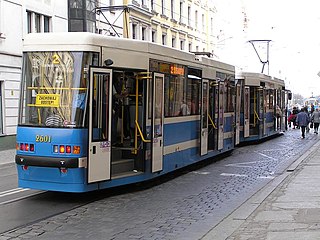
ProtramRemonty i Modernizacja Tramwajów Protram Wrocław Sp. z o.o. Polish company that specializes in producing and modernizing trams. The company was created in 1977 in Wroclaw after the conversion of the MPK Wroclaw tram-repair facility into a private company. The company filed for bankruptcy in 2016 and was eventually liquidated.

The Kraków tram system is a tram system in Kraków, Poland. The tramway has been in operation since 1882, and is currently operated by Miejskie Przedsiębiorstwo Komunikacyjne w Krakowie. There are 22 ordinary, 2 fast, and 3 night tram lines with a total line length of 347 kilometres (216 mi). As of 2013, the total route length of the tramway was 90 kilometres (56 mi), including a 1.4-kilometre (0.87 mi) tram tunnel with two underground stops.
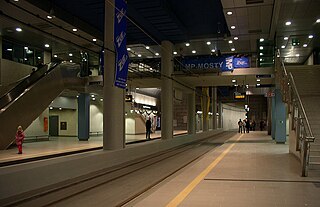
Kraków Fast Tram is a light rail network being developed in Kraków alongside the existing tramway.

Pesa Twist is an articulated low floor tram produced in Bydgoszcz by Pesa SA. The Twist is currently operated in Częstochowa, Metropolis GZM, Kyiv, Kraków, Wrocław, and Craiova. Tallinn has made an order of the trams.

Solaris Urbino 18 electric is a low-floor, articulated city bus of the MEGA class, with an electric driveline, manufactured since 2014 by Polish producer Solaris Bus & Coach in Bolechowo-Osiedle near Poznań. It is a member of the Solaris Urbino city bus family.
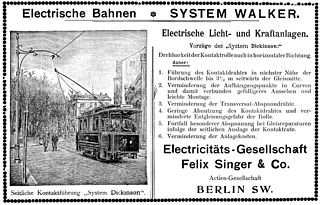
Trams in Legnica was a former streetcar system operating in Legnica, Poland, between the years 1898–1968.
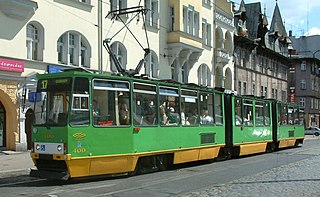
HCP 115N – the first Polish prototype partially low-floor tram that was produced by H. Cegielski factory in Poznań. It was made in 1995 from two Konstal 105N cars used by MPK Poznań and in service until 2006. In 2011 the tram has been scrapped.
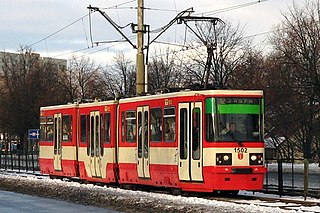
Konstal 114Na is an articulated low-floor tram, manufactured in 1997 by Konstal works in Chorzów, in a quantity of 2 units for the Gdańsk Municipal Transport Company. It is the second low-floor tram type produced in Poland after the 112N. A significant part of the solutions was taken from the previously produced single unit of the 112N type.

HCP Puma is a three-section low-floor tram manufactured by H. Cegielski in Poznań. In 2007, one prototype unit was built, which premiered on 11 June 2007 at the Poznań International Fair. From 2008 to 2011, the vehicle was leased and operated by MPK Poznań. After a drive system failure, it returned to the manufacturer.
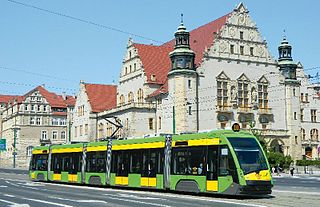
Solaris Tramino is a family of trams initially produced by Solaris Bus & Coach from Bolechowo near Poznań, and later by Stadler Polska after it acquired Solaris Tram. The prototype was unveiled in July 2009, and the delivery of series trams took place between 2011 and 2022. A total of 152 trams were produced and put into service in Germany and Poland.

Moderus Beta is a partially low-floor tram, available in either one or three sections, with a single or dual direction configuration. It is produced by the company Modertrans Poznań. These trams are in operation in the Metropolis GZM, Poznań, Szczecin, Wrocław, Elbląg, and Grudziądz. A total of 162 units have been produced.























